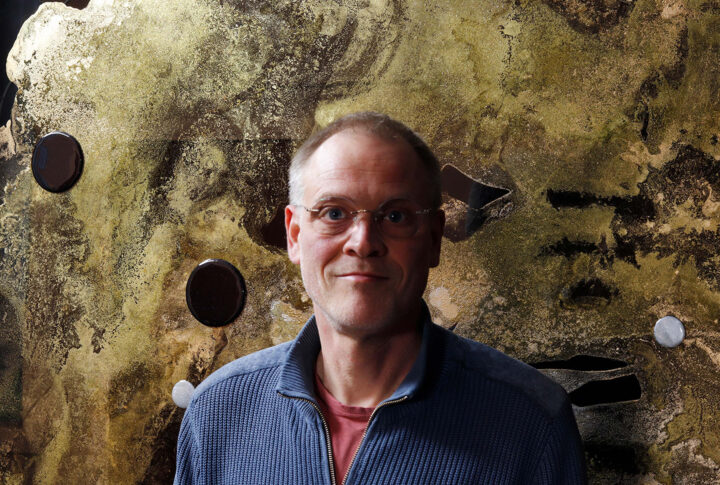
Stephan Konings is a Dutch visual artist whose paintings investigate the threshold between perception and interpretation. Working from his studio in Amsterdam, he has developed a distinctive practice that positions the viewer as co-producer of meaning.
His compositions emerge from a carefully orchestrated interplay of material, form, and chromatic rhythm. Each work begins with an amorphous structure, built through layered metallic pigments on aluminum panels. These surfaces evolve into complex, geological textures, suggesting hidden organizational logics without ever making them explicit.
Over this base, Konings introduces colored orbs made from interference mica pigments that shift chromatically with light and movement. This temporal dynamism ensures that no viewing experience is identical, reinforcing his vision of perception as an active and unstable process.
A key concept in Konings’s work is apophenia: the tendency to perceive meaningful patterns in ambiguous stimuli. Rather than treating this as cognitive error, he embraces it as aesthetic strategy. His paintings set conditions for viewers to become aware of their own pattern-seeking mechanisms, transforming apophenia from symptom into method.
“Beauty is the suspicion of a hidden system,” Konings observes. “When something appears coherent but its organizing principle remains elusive, we enter a state of heightened attention.” This tension between perceived order and unresolved structure drives both his creative process and the experience he constructs.
Konings works without predetermined outcomes. His intuitive methodology responds to what each piece requires, yielding technically precise results that arise not from conceptual imposition, but from direct material negotiation. A final epoxy resin layer seals the work while intensifying color and introducing a perceptual boundary, an optical threshold between viewer and image.
A graduate of the Gerrit Rietveld Academie in Amsterdam (1999), Konings has exhibited his work in solo and group exhibitions. His paintings are represented by www.gallery238.com and held in private collections in the Netherlands and abroad.
More information
Interview by Walter van Teeffelen:
marbellamarbella.es – World Fine Art Professionals and Their Key Pieces
Dutch version: inzaken.eu.
Music project:
Sonic Deaf Squad – (Bandcamp)
Artikel op Inzaken (Dutch)
inzaken.eu – Schoonheid is het vermoeden van een verborgen systeem